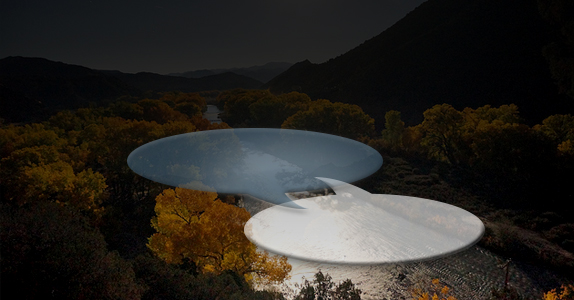
Over the last few years I’ve been following water conferences around like a Grateful Dead roadie. On January 8th a meeting I’d attended before, the Water Dialogue, met again at the Pueblo Cultural Center in Albuquerque. The first thing I thought of was lunch. If you’ve never eaten at the Center, you might be a masochist. I stopped drooling like a Pavlovian dog long enough to fill out the registration form and send it in. Even more than the lunch, I was motivated because this particular state water meeting, of all the ones I’ve gone to in the last couple of years, is the oyster that makes the pearls of wisdom that New Mexico’s leaders ought to be wearing. A return visit was in order.
This year the theme was “Learning to Live with Less Water,” not a title that puts you in a party mood. The talks and slides will be on the Water Dialogue’s web page in the near future. I won’t try to report everything that happened during the day-long session. The quality and quantity of information was well beyond overwhelming. A couple of complications replayed in my mind, though, on the drive back up the Interstate at the end of the day. First, a little something about the conference
John Fleck, environmental journalist with the Albuquerque Journal, was the keynote speaker. John has been covering water issues for years. If you don’t subscribe to his email alerts, you should, if you want short and sometimes not so sweet updates on the water situation in the Southwest. Based on the book he is doing with Island Press, and to the amazement of the water veterans at the meeting, he had the nerve to present an optimistic scenario.
Even Fleck acknowledged the bad news first, though. Peter Gleick, head of the Pacific Institute, recently tweeted that we’re stuck with 19th century infrastructure, 20th century institutions, and 21st century problems. Fleck and several other speakers repeated that mantra in different ways during the day—water governance is broken in New Mexico, among many other places, and not up to the current job. I know, this doesn’t sound like good news, though at least saying it out loud is probably a step in the right direction, sort of a “talking cure” to treat neurotic political denial.
The good news? Fleck described—based on the many water stories he has covered in the Southwest—how some front-line water people know this problem as well—or maybe even better—than the rest of us. Now and then they do something about it on their own. The examples of how this happens involved things like a river running trip, the water equivalent of the golf game where the real business is done, or the informal conversations in the hotel bar at meetings after the guns are checked at the door. Water administrators and stakeholders have, on occasion, formed personal relationships and developed their own “informal norms” to solve problems. He described in some detail, among other examples, the restoration of the Colorado river delta at the U.S./Mexican border, about as positive and environmentally friendly a story as you can imagine (See for example this National Geographic news item describing the project and the excitement just before the “flujo rapido" was let loose).
So what’s not to like? But now shift the focus to the first afternoon panel at the conference, “Reports from the Regions.” I wrote a piece for the Mercury a year ago about the “regional planning process” now underway in the state. The process itself is covered with warts—short on staff, time and money, heavy on demands, long on top-down control, no assurances from on high that its recommendations will be followed. New Mexico, it was said, is at the bottom of the Southwestern list when it comes to concern with and support for this kind of planning effort. Nevertheless, the brave souls who are doing the best job they can summarized long lists of relevant people, communities, businesses, local and distant institutions, and surface and groundwater issues that need to be brought into their planning group. Take a look at some of their slides on the Water Dialogue web page if you want to feel a sense of awe and respect for the work they’ve done so far.
Unfortunately this “official” problem-solving strategy is the before picture compared with informally connected groups who figure out a way to work under the radar of the labyrinth of water regulations and laws and solve common problems. How, I wondered, could the official way ever come to look like the Colorado River delta project, with its cast of characters ranging from D.C. bureaucrats to residents of a small town on the Mexican side of the border, all cooperating informally to get things done?
But, wait a minute. Forget the “official” regional planning agenda for a moment. Maybe, just maybe, the groups that are being assembled in each region will play some metaphorical golf and talk in the imagined hotel bar—which of course would also serve smoothies and soy lattes. Bonded by their experience of dysfunctional governance in living color, they might be inspired to informal norms and group connections and creative alternatives well outside the current water box. What if the regional planning exercise turned out to breed a movement that the old system of governance didn’t expect, one that in fact undermined it? There’s a plot twist worthy of a made-in-New Mexico movie.
But then that optimistic fantasy led to a second problem. That word “planning.” The second morning panel, called “Planning Beyond the Supply/Demand Gap,” consisted of researchers, anointed by the legislature with less money than originally budgeted, who had been charged with an assessment of the New Mexico drought. It will not shock a reader to hear that we’ve been having one for a few years. What may come as a surprise is that “drought” now isn’t like “drought” back in the 1950s, the previous bad one comparable with the present. Our drought today isn’t just about various measures of precipitation. A major reason we’re drying up is because it’s warmer now than it was then. Most Mercury readers probably know how the argument goes, warmer means faster evapotranspiration, less snowmelt, and slower aquifer recharge.
We’re in an era of climate change, a topic that—incredibly enough—the official regional planning process does not require on its to-do list for the final report. We may be in a new geological epoch called the Anthropocene. Earth is pushing back against how we have treated it. It’s mad as hell and it’s not going to take it anymore. The climate of the past twelve thousand years is over, goes the argument. The planet is turning into something different, it is doing so at an increasing rate, and we don’t know exactly what it will look like when it’s done. Water is obviously a major protagonist in this metamorphosis.
“Planning,” under these circumstances, reminds me of the old joke: “You want to make god laugh? Tell him your plans.” Planning can’t be the old “when A do B” model, because a new X will appear that wasn’t in the plan and we’ll need to figure out a Y that wasn’t in the plan either. It’s enough to make a traditional bureaucrat break out in a rash. We need to “plan” by supporting networks that learn quickly from what they just did and then improvise and innovate when the next surprise hits the fan. How do we do this for water in a coherent way at levels that run from the planet down to a tributary basin or a shared aquifer? Water people aren’t the only ones asking the question. The discussion is ongoing in governance, business, organizations of all types, social movements, and many other places. “Adaptive management” is a classic try at the right concept, in need of work, but a start. A look at the Wikipedia entry will introduce it.
Much more happened at the Water Dialogue meeting than I’m reporting here, including a panel on “preparing for the new realities” at the end, a panel that said, once again, the old days are over and new ways of thinking are called for. With this we circle back to the opening of Fleck’s plenary. Let’s look at cases where cooperation and innovation succeeded—there are several. “Water shortage sharing,” in fact, was featured at last year’s meeting of the Water Dialogue. The whole world is worried about water now and trying to figure out how to listen to what water says and start a conversation with it and amongst ourselves rather than trying to stuff what’s left of it into a pipe. Maybe we can change the famous quote that Mark Twain apparently never really said: “Whisky is for drinkin,” followed by “water is for fightin’ over.” Maybe we could try “water is for talkin’ over” and expand the conversation. It wouldn’t be easy-going harmonious small talk, but it might be worth more of a try than it gets from the old hierarchical command-and-control tradition of the Southwest.




Responses to “Water is for Talkin’ Over”